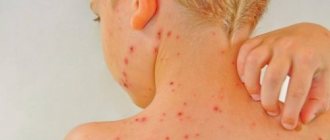Tuberculosis is a disease that is transmitted primarily by airborne droplets. Its causative agent is Koch's bacillus. Tuberculosis can be called a social disease, because 80% of patients have a fairly low standard of living.
In the modern world, it is not at all necessary to live on the street to get tuberculosis; everyone is at risk - both children and adults.
Tuberculosis in children is more severe than in adults. This is due to the fact that children are much more susceptible and weaker. It is about childhood tuberculosis that we will talk today. Let's find out what pulmonary tuberculosis is in children, how it develops and how it is treated.
- Stages of the disease in children
- Phases of tuberculosis during primary infection
- Reversal of the disease
- General symptoms
- How do the forms of the disease manifest themselves in children?
What is tuberculosis?
This is a dangerous infectious disease that affects all organs and systems. However, what she “loves” most is the lungs.
Background
Even in ancient times, there was an assumption that tuberculosis was a contagious disease. However, only in 1882, on March 24, Robert Koch announced that he had identified the causative agent of this infection, which was named after the scientist’s name - “Koch’s bacillus or bacillus.”
100 years after the discovery of the microbe, in 1982, WHO established World Tuberculosis Day on March 24. The emblem of the struggle was the white chamomile as the personification of the symbol of health and purity of the lungs.
Properties of tuberculosis bacillus
The causative agent of tuberculosis is a very stable and aggressive microbe that retains its viability for a long time: in dried sputum - up to 10-12 months, street dust - up to 2 months, water - up to 5 months. However, Mycobacterium tuberculosis (MBT) is killed by exposure to direct sunlight within a few minutes.
In addition, the tuberculosis bacillus is resistant to almost all disinfectants (for example, in a chlorine solution it is viable for up to 6 hours), as well as to many medications.
That is why you can become infected with tuberculosis quite quickly, and this disease is difficult to treat, especially if it was detected in the later stages.
How can you become infected with tuberculosis?
The source of infection is a sick person or animal releasing MBT into the environment. For information: one patient with open pulmonary tuberculosis infects about 10-15 people per year.
The most common ways to catch the “infection”:
- Airborne (95% of cases). When a patient with open form of pulmonary tuberculosis talks, coughs, or sneezes, MBT gets into the air. They spread up to 9 meters when sneezing, and 2 meters when coughing. By inhaling contaminated air, a healthy child becomes infected.
- Dust infection. With strong air movement, tuberculosis bacilli rise upward, penetrating into the lungs with inhalation.
- Contact path. Cases of damage to the conjunctiva of the eyes, lacrimal sac and skin have been described in children.
- Food route. Occurs rarely: when consuming contaminated products - through meat or milk of infected animals.
Why is the risk of getting sick higher in children?
It is believed that tuberculosis mainly affects those who are undernourished, live in poor conditions, and, due to their occupation, often come into contact with tuberculosis patients. This statement is partly true for both children and adults.
However, children still run a much greater risk of catching the “infection.” Because they have age-related structural features of some internal organs, as well as immaturity of the immune system.
Features in young children:
- Insufficient ventilation of the lungs, since the upper respiratory tract (nasal and oral cavity, nasopharynx), as well as the trachea, are short and wide. Whereas the bronchi are narrow and long.
- The cough reflex is poorly developed.
- Immature immune system . Its cells (phagocytes) capture the “stranger” well, but digest it poorly, without completely destroying it.
- The bronchial mucosa is dry because there are few mucous glands in it.
Features in teenagers:
- Neuroendocrine restructuring of the body occurs, so the immune system is somewhat delayed in responding to infection.
- The lung segments grow rapidly anatomically, but do not fully cope with their functions.
- The teenager undergoes psychological restructuring, he may develop bad habits (for example, smoking) and so on. All these factors lead to decreased immunity. In addition, the circle of contacts expands, so the risk of contact with an infected patient increases.
Thanks to all these factors, MTB “enters” the child’s body “on a white horse,” and the treatment of tuberculosis presents certain difficulties.
Development mechanism
There are three main variants of the course of tuberculosis:
- Primary tuberculosis is the time from the moment MBT enters the body until the healing of the source of the disease.
The immune system reacts very aggressively to the introduction of the bacillus into the body, localizing the process - the primary tuberculosis focus, which is usually located in the lungs). Further, in response to it, specific inflammation occurs in the lymph nodes and vessels. Thus, the primary tuberculosis complex is formed.
During this period, MBT can spread through the blood or lymph throughout the body, affecting bones, intestines, skin and other organs (especially in young children).
- Secondary tuberculosis develops in people who have previously undergone a primary process if, for a number of reasons, the primary focus worsens.
- Chronic tuberculosis intoxication - when there are no local specific changes for tuberculosis in the lungs and other organs. As a rule, there are only symptoms of general intoxication, a violation of the general condition, a prolonged increase in body temperature and weight loss. This form of tuberculosis is most common in children.
Causes
The main cause of tuberculosis is Mycobacterium tuberculosis or Koch's bacillus.
Almost all children become infected with this bacterium, but most often Koch's bacilli are inactive, so the immune system is able to cope with them. But, if a child does not eat well, is often overtired, or lives in poor conditions, then mycobacteria can become active and cause illness. These factors are risk factors for infection and development of tuberculosis.
In children under two years of age, massive spread of infection is possible immediately after infection. At older ages, the immune system manages to localize the infection at the level of the lungs, so most often they develop pulmonary tuberculosis.
There are several ways that Mycobacterium tuberculosis can enter a child’s body:
- Congenital route. The child is infected while still in the womb. But this route of infection is extremely rare. Most often, mycobacteria attack the baby during extrauterine life.
- Aerogenic path. This is the most common route of infection. In this case, mycobacteria are transmitted by droplets or through dust, on which particles of sputum excreted by patients can settle. If someone in the family has tuberculosis, the chance of the child becoming infected reaches eighty percent.
- Through food. Mycobacterium tuberculosis can enter a child's body through the milk of infected cows. Currently, this route of infection occurs in fifteen percent of cases of infection.
Tuberculosis in children: what should mothers pay attention to?
Tuberculosis has many masks, since it often manifests itself as symptoms of other diseases, and even those are sometimes mild. In addition, much depends on the organ that is affected, as well as the activity of the infectious process in general.
Signs of the disease are most clearly identified in early childhood; at 7-8 years of age, the manifestations of the disease are weak, and in adolescence, the severity of symptoms can vary.
However, there are some common specific appearances of the disease →
- Baby's complaints
As a rule, the child has no complaints or they are minor.
- Symptoms of general intoxication caused by disorders of the central nervous system:
- at an early age, the baby, for no apparent reason, becomes restless, whiny, capricious, and sleeps poorly
- the preschooler gets tired quickly, is irritable, and may react inappropriately to others (for example, unmotivated aggression)
- The student begins to study poorly, becomes absent-minded, his attention and memory decrease, and any little thing can make him angry (for example, a broken pencil).
3. Disorders of the stomach and intestines.
The child's appetite worsens and digestion is disrupted. An alarming symptom in infants - with ideal feeding, dyspeptic disorders occur (regurgitation, frequent bowel movements).
4. Losing body weight.
Occurs due to increased destruction of proteins, fats and carbohydrates. In addition, the absorption of food in the intestines is disrupted, and energy costs increase. That's why the baby is losing weight.
- Increased body temperature
In the early stages of the disease, as well as with a limited form of tuberculosis, the child, as a rule, has a normal body temperature.
With the progression of the process or prolonged course, a prolonged low-grade fever may occur - body temperature is 37-37.5 ° C, and sometimes it rises to 38-39 ° C.
Elevated body temperature with tuberculosis has its own characteristics:
- sometimes in the evening it rises slightly, and during the day it can both rise and fall significantly (by 1-2 degrees);
- in some cases, body temperature in the evening hours is no more than 37°C, and in the morning it drops to 36.0-36.2°C;
- body temperature may vary on different days, rising at unusual times;
- is of a long-term nature;
- usually well tolerated.
6. Respiratory damage
- Cough is not the leading symptom of childhood tuberculosis, so at the beginning of the disease it is either absent or not expressed.
However, if it is present , then:
- in young children it is bitonal in nature (has two tones: the main one is low, the additional one is high)
- in preschoolers and schoolchildren - dry or whooping cough (paroxysmal spasmodic)
- in adolescents it is dry or with a small amount of sputum
- long-term (more than three weeks), worsening at night.
- Sputum
It practically does not stand out, and if it is present, it is scanty and, as a rule, children swallow it.
- Hemoptysis
It is rare - mainly in teenagers.
- Dyspnea (difficulty breathing)
Absent in the early stages of the disease. However, with the progression of the disease, as well as the development of complications (pleurisy, miliary tuberculosis and others), it appears.
- Chest pain
As a rule, they are small, intermittent, and worsen with deep breathing.
- Excessive sweating
Due to the physiological characteristics of the sweat glands, healthy children practically do not sweat. Whereas with tuberculosis, the discharge from the sweat glands increases: the baby’s back and palms are constantly wet. Sweating is especially pronounced at night.
- Enlarged lymph nodes
Characteristic of tuberculosis. The first to enlarge are the lymph nodes (LNs), which are located at the roots of the lungs. The severity of the cough depends on their size.
Further, the lymph nodes above the collarbones, neck, armpits or other groups may increase. In this case, the lymph nodes become soft and painless.
Of course, these are not all the symptoms of an insidious disease; its manifestations largely depend on the damage to one or another organ (intestines, bones, and so on). But these are the signs most often observed in children. In addition, remember that often the symptoms of tuberculosis can resemble ARVI or bronchitis.
On a note.
Due to the characteristics of the immune system in young children (up to two or three years old), tuberculosis is especially severe, quickly leading to the development of complications:
- tuberculous sepsis (mycobacterium tuberculosis enters the blood)
- miliary tuberculosis (tuberculosis tubercles form in almost all organs)
- pleurisy (inflammation of the membrane covering the lungs)
- tuberculous meningitis (inflammation of the membranes of the brain and spinal cord) and others.
WHO recommendations for diagnosing the disease
The World Health Organization is concerned about the high incidence of tuberculosis in children and adolescents. The situation is primarily associated with non-specific clinical signs that complicate the timely request of parents for medical help.
Alarming statistics: children under 4 years of age are most likely to develop pulmonary tuberculosis
WHO strongly recommends paying attention to the following symptoms:
- fever within 14 days;
- cough lasting more than three weeks;
- weight loss, non-compliance with age norms for weight and height.
Children under 5 years of age are recognized by WHO as a high-risk group for possible contact with sick people. These patients require special attention when symptoms of general malaise and signs of a cold appear.
For pulmonary tuberculosis in children, sputum culture may show the absence of Koch bacteria in the material. Diagnosis of the disease is helped by skin tests and x-ray examination, which reveals darkening of the tissue of the affected lung and enlargement of the hilar nodes.
Drug therapy
Pulmonary tuberculosis in a child is treated according to a regimen identical to that for adult patients. Typically, children tolerate medications and therapeutic procedures well, and affected tissues recover much faster in childhood than in adults.
Drug treatment is conventionally divided into 2 stages:
- intensive therapy implies maximum impact on the causative agent of the disease and prevention of its resistance to drugs;
- continued therapy is aimed at eliminating remaining pathogens.
In the intensive phase of treatment, the following drugs are used: Isoniazid, Rifampicin, Ethambutol, Pyrazidamine and others. All medications are prescribed by a TB specialist strictly individually. The dosage depends on the age and weight of the small patient.
Immunomodulators, vitamins and drugs for the treatment of concomitant diseases, if any, can be used as additional means.
Treatment is carried out in specialized children's sanatoriums, where much attention is paid to regimen and nutrition, special complexes of physical therapy
Surgical intervention
Timely initiation of intensive therapy gives a good result and does not lead the patient to the surgical table. Surgical intervention in most cases is indicated for children suffering from a destructive form of pulmonary tuberculosis, in whom measures for contact and tuberculin tests have not been carried out.
If drug treatment does not bring the desired result, drastic measures must be taken. The child's lung is cleaned, mucus and lesions are removed. In 80% of cases, recovery occurs after such operations.
Indications for surgical intervention are:
- pneumosclerosis with bronchiectasis in a lobe or segment of an organ;
- caseous-necrotic changes from 1.5 to 2 cm;
- cavitary and destructive lesions that are not amenable to drug therapy;
- bronchial stenosis due to chronic intoxication due to enlarged lymph nodes.
After preoperative therapy, resection of one or two segments, sometimes a lobe, is performed. Lung resection is a fairly rare occurrence and is performed only in cases where the disease has affected one organ.
In surgery, the method of extracapsular removal of the source of infection, developed in 1983 by M. A. Trofimov, has found widespread use.
What can you do?
Of course, if you suspect (only 2-3 symptoms are enough) that your baby is sick, contact your pediatrician. Because it is necessary to determine the correct diagnosis as early as possible and prescribe adequate treatment.
And most importantly, refrain from self-treating your child with antibiotics ! Because the tuberculosis bacillus develops resistance to many drugs. Therefore, it will be much more difficult to cope with the disease later, and the risk of complications will increase.
And the child will take longer to receive treatment, and the prescribed medications to combat the tuberculosis bacillus are far from harmless.
Traditional methods
Treatment of tuberculosis with folk remedies is acceptable at home
It is important to remember that these methods cannot overcome the disease on their own and are used as a help
The following remedies are most effective:
- Birch tar. 5-10 drops of tar are dissolved in milk and taken twice a day. Improves digestion and promotes weight gain.
- Common heather. 3 tbsp. l. dry herbs, pour 1 liter of boiling water and leave for 2 hours. Use 1/2 cup before meals.
- Green tea. Has a pronounced antioxidant effect. 2-3 tsp. herbs per 1 liter of boiling water, 2-3 cups per day no later than 2 hours before bedtime.
How is the diagnosis confirmed?
The child is given the necessary tests (blood, urine), an X-ray of the lungs is taken, sputum is examined, and so on.
However, in making a diagnosis they rely on the Mantoux test. The test is carried out in order to identify the body's sensitivity to the tuberculosis bacillus that has developed as a result of infection.
By the way, a positive Mantoux test (tuberculin test) does not always indicate an active disease. Often she simply says that the rod is present in the body, but for the time being is restrained by the immune system, that is, it is simply “sleeping.” However, when exposed to unfavorable factors (stress, colds and others), it “wakes up”, causing disease.
Possible complications
Pulmonary tuberculosis is a disease that can cause serious complications. They negatively affect the functioning of the heart, liver, kidneys, they can destroy the skeleton and bone tissue.
In childhood, tuberculosis may cause pain in the heart, itching in the extremities, tachycardia, and joint pain. Complications are characterized by a long and severe course, they develop quickly and are painful. In order to determine the location of the lesion, a special test and comprehensive prevention are necessary.
Violation of the hormonal structure of the body is a specific complication of tuberculosis. It is accompanied by deterioration in health, weight gain, attacks of aggression and changes in behavior.
Treatment of tuberculosis in children
It is carried out with the same drugs as in adults: Isonoazid (preferred), Streptomycin and others. Moreover, hospitalization in a hospital is not always required.
As a rule, with timely detection and adequate treatment of the disease, the child’s general condition improves quite quickly, and the disease recedes. In addition, damaged tissues in children are restored better than in adults.
In case of infection, but without obvious signs of active disease, chemoprophylactic treatment is given.











